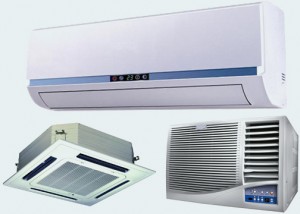Many people of Hyderabad have purchased air conditioners before the arrival of summer. A few of us are still unable to decide on which type of air conditioner to choose.
Well, this article is for those who are planning to buy an air conditioner this summer. When buying an air conditioner for the house or office, many people are very confused on which type of air conditioner to choose and what are the pros and cons of each type of air conditioner.
In this article, we have tried to solve your confusion to an extent. After reading this article, we sure you will be able to decide which one to choose from the list. So, don’t waste your time, start reading this article to know the details of various types of air conditioners.
Window AC
- Window ACs are typically installed on an open window and through the wall. It comprises one single unit.
- It is affordable, as it costs less in comparison to other types of air conditioners.
- Window ACs are ideal for smaller space or for a single room. It is available from 0.75 ton capacity to 2 ton.
- Can be easily installed with the help of just one or two people. No professional help is required. But before purchasing, make sure the window AC fits in your window. Take exact measurement to the store.
- However, window air conditioners create more noise when compared to other types of ACs. But, the new models are much quieter than the old ones.

Split AC
- Split ACs have two units – one unit is external that should be placed outside the room and another is the internal unit that is placed inside the room.
- The internal unit consists of expansion valve and evaporator coil which takes in warm air and gives out cold air. The external unit has a compressor and a condenser which removes the warm air.
- The internal unit takes less space for installation and the operation is not that noisy.
- Suitable for big rooms, halls and offices. Also for rooms without windows.
- Split ACs range from 1 ton to 5 ton in capacity.
- You will need a professional help for installation. This may cost you around Rs 1,500 to 2,000 extra.
- Split ACs cost more when compared to window ACs. But, the energy consumption of both window and split A/C is almost the same.
Tower/Floor/Free-Standing AC
- Tower AC is a free-standing floor unit. It consists of 2 units – internal and external.
- The internal (indoor) unit is moveable and can be easily installed anywhere in the room. It occupies some floor space. Does not require wall installation
- Tower AC usually comes in 1.5 ton and higher capacities.
- Professional help is needed to install the external unit and to know the features of internal unit.
- Suitable for large residential rooms and commercial places as the cooling capacity is high.
- Easy to set-up and relocate. But, exhaust tube must be re-placed, whenever you want to change the location of internal unit.
Cassette AC
- Cassette ACs have an indoor unit and an outdoor unit. Indoor unit is installed on the ceiling of the room and the outside unit is installed outside the room.
- The indoor unit does not require a window, wall or floor space for installation. They save much of your space and are usually shaped like cassettes.
- The indoor and the outdoor units are extremely quiet when in use.
- You will require a professional help to install and for the maintenance of this AC.
- Cassette ACs range from 1.5 ton to 5 ton in capacity.
- It is costly when compared to other types of air conditioners.
- Suitable for commercial shops, restaurants and large offices.
- No large, cumbersome duct work is required. But, it needs specialised false ceiling.
Central AC
- Central air conditioners are of two types – one is the split systems and the other is the packaged systems.
- The split system has the condenser and the evaporator placed in an indoor unit and the evaporator is placed inside the room. Whereas, in packaged systems all the components – condenser, compressor and evaporator are placed in a single outdoor unit.
- It is typically designed for large spaces and commercial establishments.
- Central AC usually comes in 1 ton, 1.5 ton, 2 ton and higher capacities. It provides uniform cooling and it also produces less noise.
- Central AC is quiet expensive and the installation charges are also high.
- It consumes high energy when compared to window or split AC.
- One significant disadvantage of central AC is that, once installed it cools the entire area. Individual room cooling is not possible.
We hope this article would help you in making a sensible decision while choosing an AC for your house or office.
